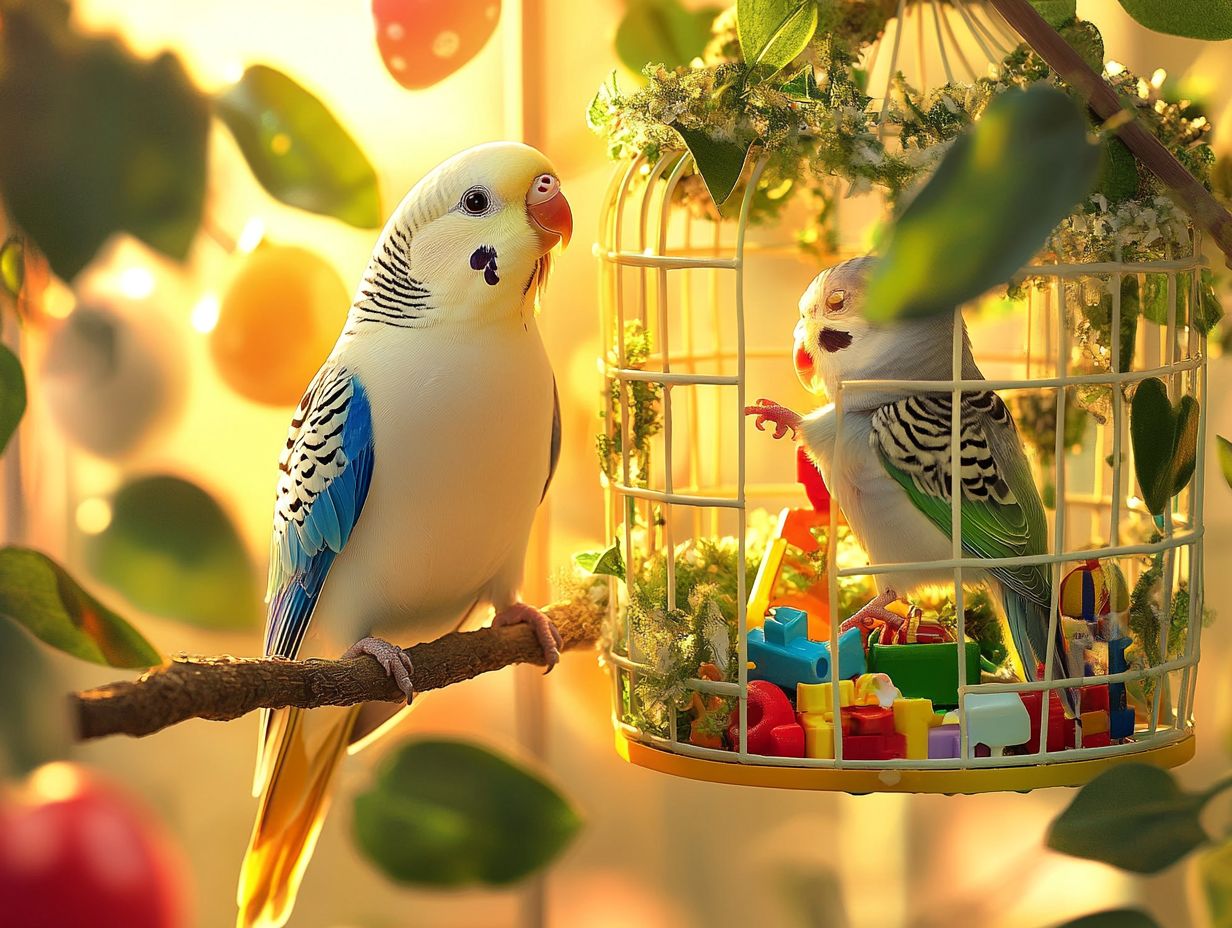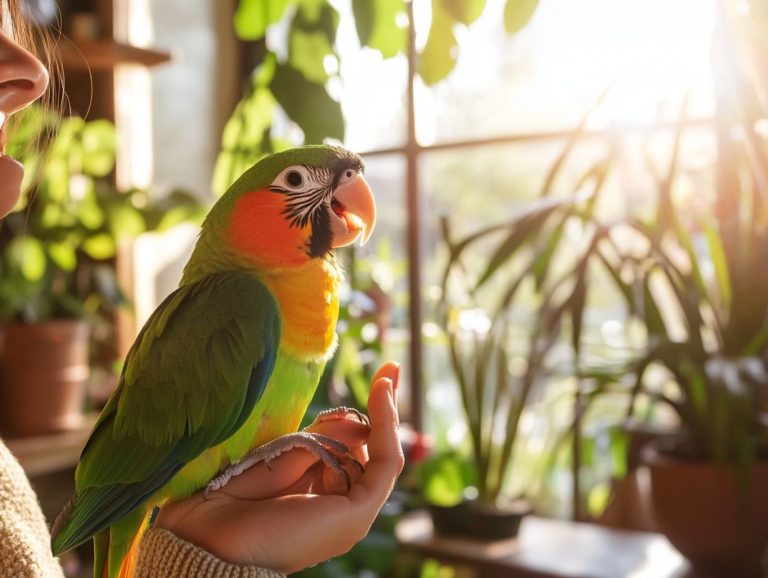What Are the Most Common Pet Bird Behaviors?
Birds captivate with their unique charm. Delving into their behaviors can deepen the connection you share with your pet.
This exploration examines the myriad factors that shape bird behavior, ranging from natural behaviors to complex social interactions. You will uncover common behaviors such as exploring, vocalizing, and engaging in mating rituals.
It also highlights problematic behaviors, offering valuable insights into their underlying causes and practical solutions. Discover how to cultivate a positive environment that nurtures these natural behaviors, ensuring your feathered companion flourishes in every way.
Contents
Key Takeaways:

- Pet birds engage in exploring, socializing, vocalizing, and reproducing.
- Address problematic behaviors by understanding their causes and implementing solutions.
- Create a positive environment by encouraging natural behaviors and providing training techniques and enrichment opportunities.
Understanding Bird Behavior
As a bird owner, you must understand bird behavior, especially in parrots and other pet birds. Consider aspects like their emotional state, social interactions, and things in their surroundings that affect their behavior. These factors can either promote normal behaviors or spark issues such as biting, screaming, or feather plucking.
Grasping the nuances of body language in avian species enables you to cultivate a stronger bond with your feathered companions. Meet their emotional needs through sufficient mental stimulation and the right training techniques to create a nurturing environment that enriches their lives and yours.
Factors that Influence Behavior
Parrots display a fascinating range of behaviors influenced by their emotional needs, social interactions, and environmental conditions. These factors can sometimes lead to challenges such as aggression and destructive tendencies.
Understanding these elements is essential. If your parrot lacks socialization or lives in subpar conditions, these issues may become more pronounced. For example, a bird that feels lonely or neglected might start screeching or engaging in feather plucking behaviors that signal distress. Recognizing that these problematic actions often stem from deeper emotional and environmental deficiencies is crucial.
Consulting an avian veterinarian can shed light on any medical issues causing these behaviors. A behavioral specialist can provide tailored strategies to effectively address and modify unwanted actions. By taking into account both emotional and environmental factors, you can foster positive behaviors in your feathered friend.
Common Behaviors in Pet Birds
Common behaviors in pet birds, especially in species like parrots, include vocalizations and preening, which reflect their emotional states and social environments. To better understand these behaviors, it’s helpful to know the signs of a happy pet bird.
This underscores the vital role of attention and mental stimulation in their daily lives, ensuring they thrive both mentally and emotionally.
Exploring and Foraging
Exploring and foraging are innate behaviors for parrots that fulfill their instinctual needs while delivering crucial mental stimulation. This not only keeps boredom at bay but enhances their overall well-being.
In a domestic setting, encouraging these natural behaviors can significantly elevate a parrot’s quality of life. Offering a variety of safe materials like paper, cardboard, and wood allows them to engage in activities that replicate their instinctive food-searching habits.
Incorporating puzzle feeders or hides filled with treats introduces environmental enrichment, challenging them to solve problems as they forage. This mental engagement not only entertains them but also nurtures their cognitive skills, helping to reduce stress and instill a sense of satisfaction in their daily routines.
Social Interactions

Social interactions among parrots are crucial for their emotional health. They significantly influence behavior and help them connect with you through effective bonding techniques.
These interactions also play a vital role in reducing problematic behaviors that can arise when parrots feel neglected or isolated. For example, an attention-seeking parrot might resort to loud vocalizations or destructive antics to grab your attention. It’s essential to understand these behaviors, especially if your parrot sees you as its primary source of affection.
In scenarios where a parrot is closely bonded to one person, establishing a routine of consistent interaction can cultivate a balanced emotional state and promote healthier dynamics in your home.
Vocalizations
Vocalizations in parrots serve many purposes, from normal chirps and contact calls to intense problem screaming. These sounds reflect their emotional states and need for social interaction.
As a parrot owner, understanding these sounds is essential. Frequent chirps might indicate happiness or excitement, while harsh screams could signal distress or boredom. By recognizing these vocalizations, you can better interpret your feathered companion’s needs. Implementing appropriate training techniques can help reduce excessive screaming.
Using methods like positive reinforcement which means rewarding good behavior and ensuring regular social interaction not only enhances communication but also addresses your parrot’s emotional needs. This thoughtful approach fosters a harmonious relationship, allowing you to enjoy the rich sounds of your parrot while creating a nurturing environment.
Reproductive Behaviors
During the breeding season, reproductive behaviors in parrots can lead to heightened hormonal activity and aggression. Understanding and managing this critical time is vital.
Hormonal fluctuations can shift a parrot’s emotional landscape, making them more irritable and inclined towards aggressive behaviors. You might observe your feathered friend becoming more territorial, vocalizing at higher volumes, or showing increased defensiveness of their space and possessions.
These shifts in behavior highlight deeper emotional needs for safety and companionship. Recognizing these signs is essential for creating a supportive environment where your vibrant companion can express itself freely, reducing the risk of escalating tensions.
This proactive approach enhances their well-being and fosters a harmonious living situation for both of you.
Problematic Behaviors in Pet Birds
Problematic behaviors in pet birds, such as biting, screaming, and feather plucking, often indicate underlying emotional issues or unmet needs that require your careful attention.
In some cases, these behaviors may even need a medical evaluation.
Causes and Solutions
Identifying the causes behind your pet bird’s problematic behaviors is vital for crafting effective solutions. This often requires a keen understanding of their environment, emotional state, and the application of appropriate training techniques.
By closely observing your feathered companion, you can gain valuable insights into their world. Changes in their environment like loud noises, the presence of other pets, or shifts in routine can profoundly impact their demeanor. Their emotional needs, such as a desire for social interaction, mental stimulation, and a secure environment, also play a significant role in their behavior.
To address these challenges, implement behavioral modification strategies such as positive reinforcement and consistent routines to encourage more desirable actions. Enhancing their environment with engaging toys and social activities can significantly boost their overall well-being, resulting in a happier, healthier pet.
Start observing your parrot today for a happier companion!
Creating a Positive Environment for Pet Birds

Creating a nurturing environment for your pet birds, especially parrots, is essential. It enhances their emotional well-being and fosters healthy behaviors. This thoughtful approach satisfies their need for mental stimulation and strengthens the bonds between you and your feathered companions.
Encouraging Natural Behaviors
Encouraging natural behaviors means providing environmental enrichment that stimulates their instincts. This includes exploring, foraging, and socializing, fulfilling their emotional and mental needs.
Creating a habitat that mirrors their wild surroundings allows them to engage in instinctual activities. It significantly reduces stress and boredom. Incorporate elements like branches, natural perches, and toys that mimic foraging opportunities. This helps cultivate a sense of security and comfort, making your feathered companions feel at home.
Such an environment promotes mental agility and enhances overall well-being. By paying attention to the specific needs of each bird species, including social interactions and opportunities for play, you contribute to their happiness and longevity. This ensures they thrive in a stimulating and fulfilling atmosphere.
Training and Enrichment
Implementing effective training techniques and enrichment strategies is vital for enhancing your parrot’s quality of life. This allows them to engage in healthy behaviors while preventing boredom and attention-seeking.
Incorporating a variety of mental and physical activities into your parrot’s daily routine creates a stimulating environment. This diminishes harmful behaviors like feather plucking and excessive screaming. Techniques such as clicker training strengthen the bond between you and your bird. They also encourage positive habits and enhance cognitive skills.
Providing opportunities for social interaction, puzzle toys, and foraging activities significantly enrich their surroundings. These experiences cater to their normal behaviors and bird body language. They challenge their problem-solving abilities and promote their natural instincts, leading to a happier and more balanced life for your avian companion.
Frequently Asked Questions
What Are the Most Common Pet Bird Behaviors?
The most common pet bird behaviors include singing, preening, playing, foraging, flocking, and vocalizing, but it’s also important to recognize the signs of a bored bird.
Why Do Pet Birds Sing?

Pet birds sing to communicate, attract mates, and mark territory.
What Does Preening Mean in Birds?
Preening is grooming and maintaining a bird’s feathers. It helps keep their feathers clean and in good condition.
How Can I Encourage My Bird to Play?
You can encourage your bird to play by providing toys, perches, and mentally stimulating activities like foraging puzzles.
Do Pet Birds Need to Be Kept in Flocks?
While pet birds can be kept alone, they are social creatures. They benefit from being kept in flocks or pairs for companionship and mental stimulation.
Why Do Pet Birds Vocalize?
Pet birds vocalize for various reasons, such as expressing emotions, communicating with other birds, and seeking attention or food from their owners.






